RBSE Class 11 Biology Important Questions Chapter 14 Respiration in Plants
Rajasthan Board RBSE Class 11 Biology Important Questions Chapter 14 Respiration in Plants Important Questions and Answers.
RBSE Class 11 Biology Chapter 14 Important Questions Respiration in Plants
Multiple Choice Type Questions
Question 1.
Glycolysis was discovered by:
(a) Dr. J.C. Bose
(b) Embden, Meyerhoff and Parnas
(c) Calvin
(d) Blackman
Answer:
(b) Embden, Meyerhoff and Parnas

Question 2.
Where the process of glycolysis is completed?
(a) In mitochondria
(b) In cytoplasm
(c) In chloroplast
(d) In nucleoplasm
Answer:
(b) In cytoplasm
Question 3.
The common pathway of aerobic and anaerobic respiration is:
(a) Kreb’s cycle
(b) Oxidative phosphorylation
(c) Electron transport system
(d) Glycolysis
Answer:
(d) Glycolysis
Question 4.
Respiration takes place even in the absence of oxygen in:
(a) peepal
(b) wheat
(c) yeast
(d) grass
Answer:
(c) yeast
Question 5.
During Kreb’s cycle, acetyl coenzyme - A combines with which of the following to form 6 - C compound:
(a) malic acid
(b) citric acid
(c) succinic acid
(d) oxaloacetic acid
Answer:
(d) oxaloacetic acid
Question 6.
The process by which the rate of aerobic respiration is inhibited by atmospheric O2 is called
(a) Pasteur effect
(b) Calvin effect
(c) Darwin effect
(d) None of these
Answer:
(a) Pasteur effect
Question 7.
In which of the following process CO2 is not released?
(a) Lactate fermentation
(b) Aerobic respiration in plants
(c) Aerobic respiration in animals
(d) Alcoholic fermentation
Answer:
(a) Lactate fermentation
Question 8.
The net gain of ATP molecules by the complete oxidation of one glucose molecule in eukaryotes is:
(a) 20 ATP
(b) 36 ATP
(c) 38 ATP
(d) 56 ATP
Answer:
(c) 38 ATP
Question 9.
ATP molecules produced respectively by NADH and FADH during electron transport are:
(a) 3 and 2
(b) 1 and 1
(c) 2 and 3
(d) 3 and 3
Answer:
(a) 3 and 2

Question 10.
What is essential for the synthesis of ATP in mitochondria?
(a) NADP
(b) FMN
(c) Oxygen
(d) Pyruvic acid
Answer:
(c) Oxygen
Question 11.
Fats are hydrolysed by the action of lipase to yield:
(a) fatty acids and amino acids
(b) glycerol and fatty acids
(c) glycerine and water
(d) glycerol and amino acids
Answer:
(b) glycerol and fatty acids
Question 12.
Oxidative phosphorylation completes in:
(a) mitochondria
(b) chloroplast
(c) ribosome
(d) cytoplasm
Answer:
(a) mitochondria
Question 13.
During EMP pathway. ATP is produced through:
(a) oxidative phosphorylation
(b) cyclic phosphorylation
(c) substrate level phosphorylation
(d) None of the above
Answer:
(c) substrate level phosphorylation
Question 14.
The currency of energy of cell is:
(a) DNA
(b) RNA
(c) ATP
(d) Salts
Answer:
(c) ATP
Question 15.
Respiratory quotient is less than one in:
(a) proteins
(b) carbohydrates
(c) organic acid
(d) None of these
Answer:
(a) proteins
Question 16.
Which of the following is not an electron transport molecule?
(a) Fe - S protein
(b) Q enzyme
(c) C0 enzyme
(d) ATP
Answer:
(d) ATP
Question 17.
During respiration, pyruvic acid is formed by:
(a) Glycolysis
(b) Kreb’s cycle
(c) TCA cycle
(d) None of these
Answer:
(a) Glycolysis
Question 18.
In electron transport system, the last electron is accepted by:
(a) molecular O2
(b) molecular H2
(c) molecular CO2
(d) NADPH2
Answer:
(a) molecular O2
Question 19.
The value of RQ is more than one in:
(a) fat
(b) fructose
(c) glucose
(d) organic acid
Answer:
(d) organic acid
Question 20.
The anaerobic respiration of yeast produces:
(a) oxygen
(b) nitrogen
(c) CO2
(d) H2O
Answer:
(c) CO2
Question 21.
The product of glycolysis used in alcoholic fermentation is:
(a) NADH2
(b) ATP
(c) ATP and NADH2
(d) CO2
Answer:
(a) NADH2
Question 22.
During night, R.Q. value in succulent plant is:
(a) 0
(b) 1
(c) 0.7
(d) more than one
Answer:
(c) 0.7
Question 23.
How many ATPs are formed by complete oxidation of glucose molecule?
(a) 8
(b) 16
(c) 32
(d) 38
Answer:
(d) 38
Question 24.
How many ATPs are formed in Kreb’s cycle?
(a) 8
(b) 12
(c) 24
(d) 36
Answer:
(c) 24
Question 25.
Kreb’s cycle is also called:
(a) EMP cycle
(b) TCA cycle
(c) Hatch - slack cycle
(d) CAM cycle
Answer:
(b) TCA cycle

Question 26.
RQ value will be most when substrate is:
(a) glucose
(b) fat
(c) malic acid
(d) protein
Answer:
(c) malic acid
Question 27.
Respiration is a:
(a) Endothermic process
(b) Degradation process
(c) Synthetic process
(d) Reducing process
Answer:
(b) Degradation process
Question 28.
Respiration rate will be increase, if amount of increases:
(a) N2
(b) O2
(c) CO2
(d) CO
Answer:
(b) O2
Question 29.
Alcoholic fermentation takes place in the presence of:
(a) maltase
(b) zymase
(c) amylase
(d) invertase
Answer:
(b) zymase
Question 30.
ATP formation in mitochondria takes place on:
(a) external membrane
(b) inner membrane
(c) F1 particle
(d) Cristae
Answer:
(b) inner membrane
Question 31.
In which process CO2 is not released?
(a) Aerobic respiration in animals
(b) Aerobic respiration in plants
(c) Alcoholic fermentation
(d) Lactate fermentation
Answer:
(d) Lactate fermentation
Question 32.
Which of the following is/are a respiratory inhibitor/s?
(a) Iodoacetate
(b) Malonate
(c) Cyanide
(d) All of these
Answer:
(d) All of these
Question 33.
Anaerobic respiration takes place in a higher plant:
(a) moist seed
(b) fruit
(c) leaf
(d) dry seed
Answer:
(d) dry seed
Question 34.
Kreb’s cycle begins with:
(a) pyruvic acid
(b) HCl
(c) acetyl Co - A
(d) citric acid
Answer:
(c) acetyl Co - A
Question 35.
ATP means:
(a) Adenosine triphosphate
(b) Adenine triphosphate
(c) Adenine diphosphate
(d) Adenosine diphosphate
Answer:
(a) Adenosine triphosphate
Very Short Answer Type Questions
Question 1.
Define respiration.
Answer:
Respiration is a process in which complex organic substances, present in the cells, are decomposed into simple substances by oxidation and energy is released.
Question 2.
Write equation for aerobic respiration.
Answer:
C6H12O6 + 6CO2 → 6CO2 + 6H2O + 673 kcal.
Question 3.
Where does electron transport takes place in cellular respiration?
Answer:
On oxysomes of mitochondria.

Question 4.
How respiration process is affected at high temperature?
Answer:
The enzymes are denatured at high temperature, hence, respiration rate reduces.
Question 5.
Which step is common for both aerobic and anaerobic respiration?
Answer:
Glycolysis.
Question 6.
Which two molecules in cells functions as banker?
Answer:
NAD and FAD.
Question 7.
Which cell organelle is called power house of the cell?
Answer:
Mitochondrion.
Question 8.
Where does Kreb’s cycle occurs in cell?
Answer:
In mitochondria.
Question 9.
What is the energy currency of cell?
Answer:
ATP (Adenosin triphosphate).
Question 10.
What is incomplete oxidation of glucose into pyruvic acid called?
Answer:
Glycolysis.
Question 11.
How many glucose molecules are utilize for production of 38ATP molecules in anaerobic respiration in yeast?
Answer:
In anaerobic respiration, 2 ATP molecules are formed from one molecule of glucose. Thus for production of 38 ATP, 19 glucose molecules are required.
Question 12.
Name the enzyme which converts glucose into glucose - 6 - phosphate in glycolysis.
Answer:
Hexokinase.
Question 13.
Write Want Haff rule.
Answer:
According to Want Haff rule, the respiration rate increases 2 - 3 times with increasing of temperature per 10°C.
Question 14.
The anaerobic respiration is going on by an organism on glucose. What will be its RQ?
Answer:
Indefinite, because there O2 is not absorbed in anaerobic respiration.
Question 15.
How many ATP are formed during formation of acetyl Co - A from pyruvic acid?
Answer:
2 ATP.
Question 16.
Write one difference between respiration and combustion.
Answer:
Combustion takes place at higher temperature while respiration takes place at normal temperature.
Question 17.
Write two respiration inhibitors.
Answer:
Carbon monoxide, iodoacetate.
Question 18.
Which is the last electron acceptor in ETS?
Answer:
Oxygen.
Question 19.
Write the role of ATPase.
Answer:
Formation of ATP from ADP and ip.

Question 20.
What is zymosis?
Answer:
It is an other form of fermentation.
Question 21.
How many types of respiration?
Answer:
There are two types of respiration: Aerobic respiration and Anaerobic respiration.
Question 22.
How does exchange of gases occurs in plants?
Answer:
There are simple diffusion through stomata.
Question 23.
Name the bacteria which convert lactose sugar of milk into lactic acid.
Answer:
Lactic acid bacteria.
Question 24.
What is the degradation of sugar by yeast cells called?
Answer:
Alcoholic fermentation.
Question 25.
What is called ‘Mediator of energy’?
Answer:
ATP.
Short Answer Type Questions - I
Question 1.
Write RQ value of following:
(i) Germinating starch wheat.
(ii) Germinating oil seed.
(iii) Germinating pulse seed.
(iv) Opuntia in light.
Answer:
(i) RQ of respiration of carbohydrate in germinating wheat = 1
(ii) RQ of respiration of fat in germinating oil seed = 0.64
(iii) RQ of respiration of protein in germinating pulse - seed = 0.8 - 0.9.
(iv) Deacidification occurs in opuntia in light, thus RQ = 133.
Question 2.
Why muscles of animals feel fatigue?
Answer:
The energy expenditure occurs in animals at working which is obtained by anaerobic respiration by muscles. In this process lactic acid is accumulated in muscles. Due to excessiveness of lactic acid the muscles feel fatigue.
Question 3.
What is Pasteur effect?
Answer:
A process of converting anaerobic conditions of an organism into aerobic conditions is called pasteur effect. This process is done for preserved foods (substrate).
Question 4.
An alive rabbit is kept in a air tight glass bell jar which is connected with a trough in which green algae is growing. Would rabbit be the alive for some time? Give reason.
Answer:
Any living organism can alive for a time without food, but not without respiration. The rabbit needs oxygen for respiration, which is obtained by him from trough. But algae release O2 during day only, at night algae release CO2. Thus during night, the rabbit can be die in the absence of O2.

Question 5.
How respiratory quotient is calculated in succulent plants like Opuntia?
Answer:
In day time, incomplete oxidation occurs in Opuntia.
C6H12O6 + 3O2 → C4H6O5 + 2CO2 + 3H2O
\(\text { R.Q. }=\frac{\text { Volume of. } \mathrm{CO}_{2} \text { released }}{\text { Volume of } \mathrm{O}_{2} \text { absorbed }}=\frac{2}{3}=0.67\)
During night, there deacidification occurs in Opuntia.
C4H6O5 + 3O2 → 4CO2 + 3H2O
\(\text { R.Q. }=\frac{\text { Volume of } \mathrm{CO}_{2} \text { released }}{\text { Volume of } \mathrm{O}_{2} \text { absorbed }}=\frac{4}{3}=1.33.\)
Question 6.
Write two differences between Respiratory Quotient and Photosynthetic Quotient.
Answer:
Difference between Respiratory Quotient and Photosynthetic Quotient.
|
Respiratory Quotient |
Photosynthetic Quotient |
|
1. It is ratio of released CO2 to absorbed O2 in a definite time period. |
1. It is ratio of released O2 to absorbed CO2 in a definite time period. |
|
2. The R.Q. for different substrates is different. |
2. P.Q. of almost all plants is 1. |
Question 7.
Write two importance of fermentation in daily life.
Answer:
Importance of Fermentation:
- Several milk products such as curd, butter, paneer etc., are obtained by the help of bacterial fermentation.
- Curing in the leaves of tobacco and tea is done by the help of certain bacterial fermentation, due to which bitterness of leaves is removed and a special type of aroma is produced in them.
Short Answer Type Questions - II
Question 1.
What is aerobic respiration? Why it is considered more efficient than anaerobic respiration?
Answer:
Aerobic respiration: A type of respiration which occurs in the presence of oxygen is called aerobic respiration.
C6H12O6 + 6O2 → 6CO2 + 6H2O + 673 kcal
Aerboic respiration is more efficient than anaerobic respiration because:
- The number of ATP formed in glycolysis is equal for both types of respiration.
- In aerobic respiration, there complete oxidation of pyruvic acid takes place by Kreb’s cycle. The released energy stored in as ATP.
- In anaerobic respiration, CO2 and alcohol are formed by only internal change. Most of energy remains in these compounds.
- In aerobic respiration, 38 ATPs are formed while in anaerobic respiration only 2 ATPs are formed.
Thus, aerobic respiration is more efficient than anaerobic respiration.
Question 2.
Respiration also takes place in the absence of oxygen. How can you prove? Explain with experiment.
Answer:
The oxygen is not required for the formation of pyruvic acid from glucose in the first step of respiration. It is called glycolysis. The anaerboic respiration takes place in the absence of oxygen.

The above process can be understood by following experiment.
Experiment: A test tube completely filled with mercury is inverted over a mercury filled petridish. Few gram seeds soaked in water are taken and their seed coats are carefully removed.
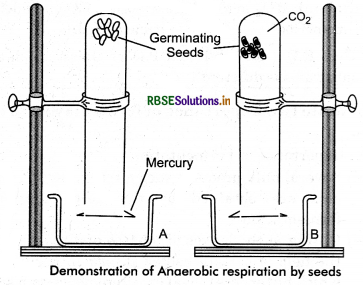
The gram seeds are introduced into the test tube from below with the help of a forceps. The seed floats up to the top of the test tube. After some time mercury level falls in the upper end of the tube due to accumulation of carbon dioxide gas released from the respiring seeds. The gas, liberated by the seeds, is CO2 is proved by introducing a small caustic potash pellet through the lower end of the tube. The CO2 absorbed by KOH and therefore, the mercury level, therefore rises and fills the tube completely. It shows that CO2 is liberated by the process of respiration. In this experiment oxygen is not required but respiration is done.
Question 3.
Demonstrate respiration process by using green plant.
Or
Prove that CO2 is liberated in aerobic respiration.
Answer:
Take bell jar with a green plant and other bell jars and tubes are fitted as shown in figure. In case of germinating seeds the bell jar is replaced by a U - tube, within which the seeds are kept. The connections are made air tight. When the aspirator is on air enters first into the KOH solution where CO2 of the air is absorbed. Air almost free from CO2 then enters into the second bottle which contains lime water. Whatever CO2 is still left in the air is absorbed by the lime water. Air completely free of CO2 then enters into the bell jar where the plant respire with the help of atmospheric oxygen. Air enriched with the CO2 released in the aerobic respiration of the plant, enters the bottle containing the lime water. CO2 released during respiration turn lime water milky. It is proved that CO2 is evolved in the process of aerobic respiration.
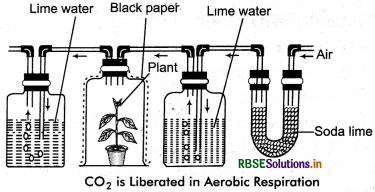
Question 4.
How Show give the demostration of aerobic respiration by respiroscope?
Answer:
Demonstration of aerobic respiration by respiroscope: The respiroscope is an apparatus made of glass in which a bulb is fitted on one end of curved end tube. The bulb also has a mouth with cork. The respiroscope is fixed vertically to a stand a few germinating seeds are placed in the bulb. The vertical tube of the respiroscope is dipped just below the surface of water or mercury in a beaker.
A few caustic potash (KOH) pellets are introduced in the bent portion of the respiroscope. The apparatus is allowed to stand for a few hours when it is seen that water or mercury has risen in the vertical tube of the apparatus providing the production of partial vaccum. Due to respiration of germinating seeds CO2 has been released which at once gets absorbed by KOH pellets. Thus, the partial vaccum produced by the absorption of O2 by the respiring material, could not be filled up by the released CO2. Hence, water or mercury is drawn upward into the tube.
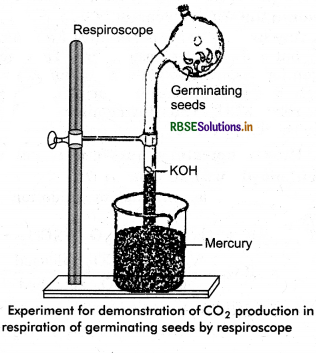

Question 5.
What would you expect when yeast cells are kept in sugar solution?
Or
The fresh juice of date palm is sweet than the juice which is remained lingeringly. Why this juice becomes narcotic?
Answer:
These following changes are shown in sugar solution with yeast cells. These alcoholic fermentation get started in sugar solution by yeast cells as a results, zymase enzyme present in yeast cells acting on sucrose breakdown to glucose etc. Later alcohol and CO2 are produced from glucose by anaerobic respiration. The energy produced in this process rises the temperature of the solution.
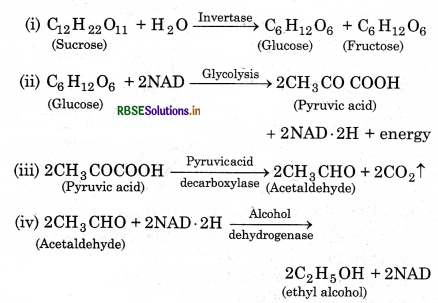
The yeast cells absorb sufficient nutrition and energy growing well and increase their number. The lingeringly placed juice of date palm goes in to fermentation to produce alcohol which is narcotic.
Question 6.
Write the difference between photosynthesis and respiration.
Answer:
|
Respiration |
Photosynthesis |
|
1. It is a catabolic process. |
1. It is an anabolic process. |
|
2. Oxygen is absorbed and carbon dioxide is released in this process. |
2. Carbon dioxide is absorbed and oxygen is released in this process. |
|
3. There is loss in dry weight of plant. |
3. There is gain in the dry weight of plant. |
|
4. This process does not depend on light and goes on day and night. |
4. It takes place only in presence of light. |
|
5. It occurs in all the living cells. |
5. It occur only in chlorophyll containing cells. |
|
6. The raw materials are glucose, proteins, fat and oxygen. |
6. The raw materials are carbon - dioxide (CO2) and water (H2O). |
|
7. Chlorophyll is not required. |
7. Chlorophyll is required. |
|
8. It is an exothermic process. |
8. It is an endothermic process. |
|
9. In this process, dehydrolysis and decarbo - xylation are occurs. |
9. In this hydrolysis and decarboxylation does not occur. |
|
10. The stored chemical energy is released. |
10. The light energy is stored as chemical energy. |
|
11. The food materials are oxidised. |
11. The food materials are synthesized. |
|
12. 36 ATPs are formed by the oxidation of one molecules of glucose. |
12. 18 ATPs are required for the synthesis of one molecule of glucose. |
Question 7.
What is the reason that on opening of door of godown, there is feeling of heat?
Or
The temperature inside the grass is more that of outer environment.
Answer:
There energy is released when we open the door of godown. It is because the seeds are alive and in them slow respiration occurs. Thereby heat is released, which perceived by us. As Much is happens in heap of grass, the respiration occurs for a long time in cut grass leaves. In which energy is released which causes inner environment hot.
Question 8.
Write short notes on acetic acid fermentation and lactic acid fermentation.
Answer:
- Acetic Acid Fermentation: In some bacteria ethyl alcohol is oxidised into acetic acid by alcoholic fermentation, it is called acetic acid fermentation.

- Lactic Acid Fermentation: This process occurs in some tissues of higher plants, muscles of animals and some bacteria such as Lactobacillus lacti etc. In this pyruvic acid and then lactic acid is formed from glucose in the presence of enzyme.

- The fermentation process takes place fast under anaerobic conditions.
Question 9.
Write short notes on the following:
(i) Protoplasmic respiration.
(ii) Floating respiration.
(iii) Salty respiration.
Answer:
(i) Protoplasmic respiration: In respiration, when the respiratory substance is protein, then it is called protoplasmic respiration.
(ii) Floating respiration: When respiratory substance is carbohydrates then it is called floating respiration.
(iii) Salty respiration: When plants are kept in salty water, the rate of respiration increases, it is called salty respiration.
Question 10.
Classify the living organisms based on respiration.
Answer:
On the basis of respiration, organisms can be classified as following:
- Obligate aerobes: These organisms respire only under aerobic conditions, i.e., O2 is essential for their survival, e.g., most of the animal and plants.
- Facultative aerobes: These organisms are basically anaerobes but under certain conditions, they can respire under aerobic conditions also. e.g., yeast.
- Obligate anaerobes: These organisms respire only under anaerobic conditions. These organisms cannot survive in the presence of O2 only. e.g., Clostridium bacteria.
- Fucultatlve anaerobes: These organisms are basically aerobes but under certain conditions, they can respire under anaerobic conditions also, e.g., lactic acid bacteria.
Question 11.
Write special features of glycolysis.
Answer:
Special Features of Glycolysis:
- It begins with one molecule of glucose.
- Two molecules of pyruvic acid are formed from one molecule of glucose at the end of this process.
- The glycolysis is a series of reactions takes place in the presence of different enzymes.
- 4 molecules of ATP are formed in this process but two of them are utilized in the phosphorylation. Therefore, the net gain of ATP in the process is 2 ATP molecules.
- Two molecules of NADH2 are formed in this process. In the presence of oxygen, on the availability of O2, i.e., in aerobic respiration, there is additional gain of 6 molecules of ATP. Hence, in the presence of O2, 8 molecules of ATP are obtained in glycolysis.
- The energy of glucose is stored in the form of ATP and NADH2.
- The process of glycolysis does not require O2 and there is no output of CO2
Long Answer Type Questions
Question 1.
What do you understand by Malate - Aspartate shuttle and Glycerol - Phosphate shuttle.
Answer:
1. Malate - Aspartate Shuttle: The electrons from NADH2, produced in cytosol, are transferred to malate by this shuttle. Malate enters to the mitochondrial matrix and reacts with NAD to form NADH2 and oxaloacetate. The synthesis of aspartate takes place by the ammonification of OAA which enters the cytosol from mitochondria and is converted into oxaloacetate. This shuttle is found in the cells of liver, heart and kidney. In this shuttle no energy is required in transferring NADH2 to mitochondria, i.e., this shuttle is more efficient to work.
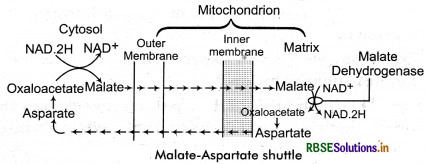
2. Glycerol Phosphate Shuttle: In this shuttle, NADH2, produced in cytosol, transfer its electrons to glycerol phosphate. Which now enters the inner membrane of mitochondria and reacts with FAD to form FADH2 and dihydroxyacetone phosphate. It returns to the cytosol. This shuttle is usually found in eukaryotic cells. In this shuttle, energy is required to transfer NADH2 to mitochondria i. e., this shuttle has low efficiency to work.
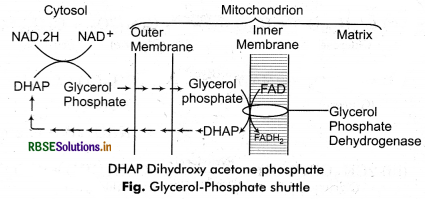
Question 2.
Describe the process of glycolysis.
Or
What is EMP pathway? Describe its various steps in brief.
Answer:
Glycolysis is also called EMP - pathway because it was discovered by three German scientists; Embden, Meyerhof and Parnas. It is also known as common respiratory pathway or cytoplasmic respiration all the reaction of EMP - pathway takes place in cytoplasm. In glycolysis, two molecules of pyruvic acid (3 - carbon compound) are formed from one molecule of glucose (6 - carbon compound). Glycolysis includes the following steps:
I. First Phosphorylation: First of all one molecule of glucose is phosphorylated in the presence of ATP to form glucose - 6 - phosphate. This reaction is catalysed by enzyme hexokinase, and Mg++ serves as cofactor.

II. Isomerization: Glucose - 6 - phosphate is isomerized to form fructose - 6 - phosphate. This reaction is catalysed by enzyme phosphohexoisomerase or phsophoglucoiso - merase.

III. Second Phosphorylation: Fructose - 6 - phosphate so formed, is again phosphorylated by ATP molecule to form fructose - 1, 6 - di - phosphate. This reaction is catalysed by enzyme phosphofructokinase and Mg++ acts as cofactor.

In above reactions, two molecules of ATP are used in the formation of one molecule of fructose - 1, 6 - diphosphate from the both phosphorylations of one molecule of glucose.
IV. Splitting of Hexose Sugar: In this step, 6 - carbon compound fructose - 1, 6 - diphosphate now splits into two molecules of 3 - carbon compounds 3 - phosphoglyceralde - hyde and dihydroxyacetone phosphate. This reaction is catalysed by enzyme aldolase.
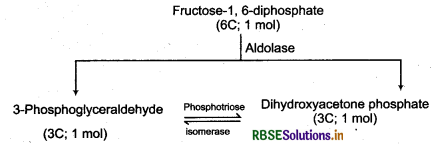
Of the two molecules, only 3 - phosphoglyeeraldehyde is oxidized. As further oxidation of 3 - phosphoglyceraldehyde proceeds, dihydroxyacetone phosphate is converted into 3 - phosphoglyceraldehyde. This intra transformation is catalysed by the enzyme phosphotriose isomerase. In this way only 3 - phosphoglyceraldehyde molecules take part in further reactions.
V. Phosphorylation and dehydration: 3 - phosphoglycer - aldehyde reacts with phosphoric acid(H3PO4)to form 1, 3 - diphosphoglyceraldehyde (DiPGAL).

VI. Formation of 1, 3 - diphosphoglyceric acid: 1, 3 - dip - hosphoglyceraldehyde undergoes oxidation to yield 1, 3 - diphosphoglyceric acid (DiPEA) in the presence of
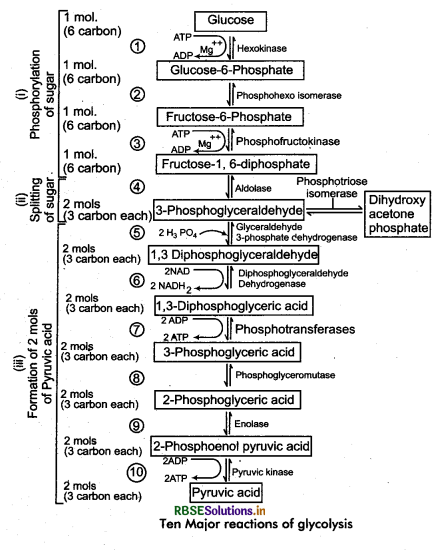
enzyme phosphoglyceraldehyde dehydrogenase. In this reaction, NAD functions as hydrogen acceptor.

VII. First ATP Generation: In this reaction, one phosphate group from each of the two molecules of 1, 3 - diphosphoglyceric acid are transferred to two ADP molecules, thus forming two ATP molecules. Now 1, 3 - diphosphoglyceric acid is converted into 3 - phosphogly - ceric acid and this reaction is catalysed by the enzyme phosphotransferase.

VIII. Isomerisation: 3 - phosphoglyceric acid is converted into its isomer 2 - phosphoglyceric acid in the presence of enzyme. Phosphoglyceromutase.

IX. Dehydration: In this reaction, one molecule of water is removed from each molecule of 2 - phosphoglyceric acid resulting in the formation of phosphoenol pyruvic acid in the presence of enzyme enolase.

X. Second ATP Generation: In this step of glycolysis the phosphate group gets isolated from each molecule of phosphoenol pyruvic acid resulting in the formation of pyruvic acid. This reaction is catalysed by the enzyme pyruvic kinase.

The complete process of glycolysis can be summerised by the following equation:

Such a way thus two molecules of pyruvic acid are formed from one molecule of glucose.
There are 3 major ways in which pyruvic acid produced by glycolysis is handled:
- By aerobic respiration
- By lactic acid fermentation (anaerobic)
- By alcoholic fermentation (anaerobic)

Question 3.
What do you mean by aerobic respiration? Describe Kreb’s cycle with diagram.
Answer:
It has been discussed earlier, that aerobic respiration is the process in which oxygen is required. Although above glycolysis process is common to both aerobic and anaerobic1 respiration but when the breakdown of pyruvic acid takes place in the presence of oxygen, then it is called aerobic respiration. If the break - down of pyruvic acid occurs in absence of oxygen, then it is called anaerobic respiration.
In the presence of oxygen, pyruvic acid is decomposed into carbon dioxide and water and the energy produced during this process is stored in the form of ATP. The pyruvic acid formed in the cytoplasm enters the mitochondria because all the enzymes related to aerobic respiration are found in mitochondria only, i.e., this process takes place in the cell, hence, it is known as cellular respiration.
The pyruvic acid produced by glycolysis in cytoplasm now enters the matrix of mitochondria where its oxidative decarboxylation takes place in the presence of NAD and sulphur containing compound co - enzyme A. During this process, one molecule of CO2 is released from pyruvic acid and NADH2 is also formed, and in the end acetyl co - enzyme - A is formed. In fact, the formation of acetyl co - enzyme - A from pyruvic acid by oxidative decarboxylation is complex process in which three enzymes such as pyruvic acid decarboxylase; dihydrolipyl transacetylase and dihydrolipyl dehydrogenase and six co - factors such as Mg++, thiamine pyrophosphate (TPP), NAD, Co - A, FAD and lipolic acid are involved. The summary for this step is

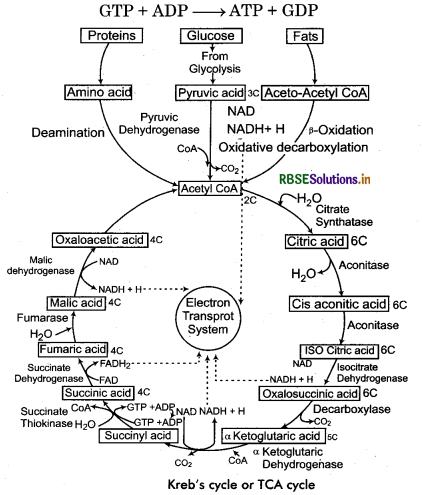
Question 4.
Explain electron transport system.
Answer:
Electron transport system is also called oxidative phosphorylation. The dissociation of glucose molecule in the presence of oxygen is the process of oxidation. Glucose molecule is completely oxidized by the end of Kreb’s cycle. However, energy is not released until NADH2 and FADH2 are oxidized. The synthesis of ATP with the help of energy released by the oxidation of NADH2 and FADH2 is called oxidative phosphorylation. But NADH2 or FADH2 does not combine directly with oxygen, the electrons reach to oxygen from them through a series of electron carriers. This series of electron carriers is known as electron transport chain or electron transport system.
The formation of electron transport chain occurs by many co - enzymes such as: NAD, FMN, FAD, co - enzyme Q, cyt - b, cyt - c, cyt - 1, cyt - c, cyt - a and cyt - a3. All these co - enzymes are found in Ft particle situated on the inner membrane of mitochondria.
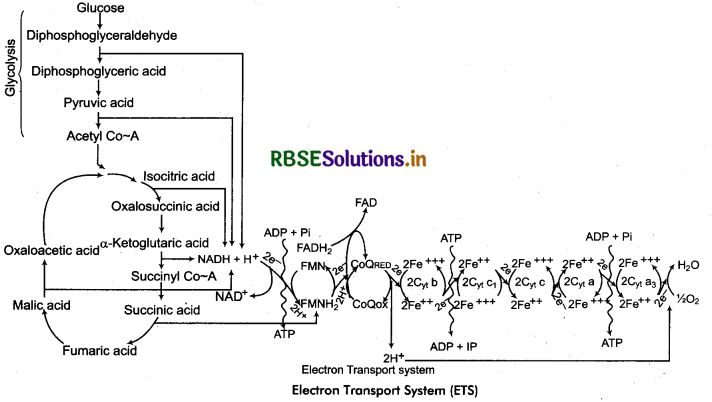
Different Steps of Electron Transport System
1. In first step of electron transport system, FMN is reduced to FMN H2 receiving hydrogen from NADH2 and NADH2 itself gets oxidized. ADP and inorganic phosphate (iP) combine to form ATP in oxidative phosphorylation by using free energy released in this step.
2. One pair of hydrogen is first transferred from succinic acid to FAD to form FADH2.
3. Both FMNH2 and FADH2 gets oxidized by transferring their hydrogen to co - enzyme - Q, and it gets reduced to Co - QH2.
4. The reduced co - enzyme - QH2 decomposes hydrogen into electrons and protons.
2H → 2H2+ + 2e-
5. Co - enzyme - Q now gets oxidized to transferring of electrons to cytochrome. First of all reduced co - enzyme - Q transfers electron to cyt - b which later on itself gets reduced. Now, cyt - c1, cyt - c, cyt - a and cyt - a3 go on reducing and Oxidizing, respectively by electrons.
6. The reduced cyt - a3 loses a pair of electrons which are accepted by molecular oxygen alongwith the pair of proton (2H+) to form one molecule of water (H2O). Therefore, oxygen is the last acceptor of electrons in ETS.
\(\frac{1}{2}\) O2 + 2e- → O-- ; 2H+O-- → 2H2O
The first molecule of ATP is generated between NAD and FMN. The second and third ATP molecules are generated when electrons are transferred from cyt - b to cyt - c1; and cyt - a to cyt - a3. Since succinic acid denotes its H2 to FAD, under this condition the first molecule of ATP does not form. Therefore 3 ATP molecules are produced from each NADH2 molecule and 2 ATP molecule from each FADH2 molecule.
Question 5.
Define fermentation and explain various types of fermentation processes.
Answer:
In several micro - organisms, the process of respiration takes place in the absence of oxygen and it is related to other process of their life. For example, microorganisms found in those medium (colloidal solution of any organic material or other moist substance). First make it soluble and absorbable by some digestive processes then absorbed get it. These nutritives reacting in body of organism, dissociated in the absence of O2. The energy released in this is utilized in various vital activities.
In this process, complete degradation of food material occurs nor total energy gained. In complete degradation substance is released into environment.
The above reaction is collectively called fermentation. It is shortly defined as:
This process resembling anaerobic respiration in which various organic substances are decomposed by the activity of micro - organisms to form substances is called fermentation. This process is usually found in fungi and bacteria. The enzymes related to this process are present in a complex group. Such as in yeast, it is called zymase group.
Characteristics of Fermentation
- In fermentation, the substrates are present outside the cell.
- This process always occurs in liquid medium.
- This process does not require oxygen.
Types of Fermentation
On the basis of end products formed during fermentation, the fermentation is of following types:
1. Alcoholic Fermentation: This process usually found in yeast. The process of formation of ethyl alcohol arid carbon dioxide from glucose molecule is called alcoholic fermentation. This process occurs in the sugar solution by yeast cells. Yeast cells secrete enzyme of zymase group which dissociates sugar into alcohol and CO2. The steps involved in alcoholic fermentation are as follows:
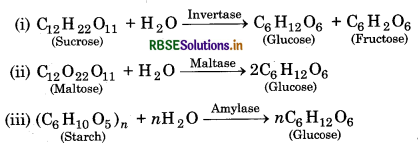
After this glucose is converted into pyruvic acid by glycolysis:

Pyruvic acid degrades into ethyl alcohol and CO2 by two steps:

2. Lactic Acid Fermentation: In this type of fermentation, lactic acid is produced from sugar. Lactic acid bacteria ferment the milk sugar to form lactic acid due to which milk becomes sour. Bacterium lactic acidi and Bacterium acidi lactici are found in milk which convert milk sugar into lactic acid.

Lactic acid and ethyl alcohol are formed and CO2 is evolved from glucose in the presence of Bacterium lactici acidi.

3. Butyric Acid Fermentation: This type of fermentation occurs by Bacillus butyricus and Clostridium butyricum. These bacteria convert sugar and lactic acid into butyric acid.

4. Acetic acid Fermentation: Unlike other fermentations, atmospheric oxygen is utilized in this type of fermentation. Acetobacter aceti bacterium oxidizes ethyl alcohol into acetic acid in the presence of oxygen. This bacterium helps to form vinegar.

Importance of Fermentation
- The fermentation process have great importance in our domestic life and in industries. Alcoholic fermentation by bacteria and yeasts is very useful in wine industries for making wine, whisky, beers etc.
- Bacterial fermentation plays an important role in retting of some plants such as sunhemp, jute, flax etc., to produce fibres.
- Acetic acid bacteria convert ethyl alcohol into vinegar.
- Curing in the leaves of tobacco and tea is done by the help of certain bacterial fermentation due to which bitterness of leaves is removed and a special type of aroma is produced in them.
- The tanning of leather of hides of animals is done by the help of bacterial fermentation process.
- Several milk products such as curd, butter, cheese etc. are also obtained by the help of bacterial fermentation.
- Several types of organic acids like lactic acid, acetic acid, citric acid etc., are formed by the help of bacterial fermentation.
- Many bacteria destroy our food materials through fermentation.
Factors affecting Fermentation
- The presence of oxygen reduces fermentation because fermentation is an anaerobic process.
- High light intensity decreases fermentation.
- Fermentation process increases with increasing temperature.
- The concentration of substrate and products also affect fermentation.

Question 6.
Write the factors affecting respiration.
Answer:
Factors affecting the rate of respiration can be classified into two groups:
(A) External Factors
- Concentration of respiratory substrate: The rate of respiration increase at increasing the concentration of respiratory substrate. When respiratory substrate decreases, the rate of respiration also decreases.
- Protoplasm: The rate of respiration is directly proportional to the quantity of protoplasm. If the quantity of protoplasm is more in cell, the rate of respiration is also high.
- Enzyme: The quantity and types of enzymes, Dresent in the protoplasm also affect the rate of respiration.
- Other: The quantity of water, age of cells etc., also affect the rate of respiration.
(B) External Factors
1. Temperature: The temperature for respiration is usually 5°C - 25°C. The gradual increase in temperature between 0°C - 35°C there is also increase in the rate of respiration. The optimum temperature for respiration varies between 25° - 30°C. But increase in temperature beyond 30°C there is gradual decrease in the rate of respiration.
2. Oxygen: Oxygen is highly essential for respiration because respiration is an oxidation process. The sufficient concentration increases the rate of respiration but at high concentration inhibits enzyme activity, thereby rate of respiration reduces.
3. Light: It has no direct effect on respiration. In high light intensity, the formation of carbohydrates by photosynthesis increases which is used in respiration. Hence, the rate of respiration also increases.
4. Water: All the vital activities takes place in the presence of water. The enzymes remain active in the presence of water. The increase in quantity of water increases the rate of respiration to some extent.
5. CO2: When the concentration of carbon dioxide in atmosphere becomes more than normal, the rate of respiration becomes low.
6. Chemical inhibitors: Various substances such as acetone, ether, chloroform etc., when present in low concentration, increase the rate of respiration. But at high concentration, they decrease the rate of respiration. Cyanides, CO, azides, etc., inhibit the activity of useful enzymes, resulting into the decrease in the rate of respiration.
Respiratory Pathway in an Amphibolic Pathway
Glucose is a common substrate for respiration process, which is called cellular fuel. Other carbohydrates are also converted into glucose before respiration. The fats first are degraded into glycerol and fatty acids. Fatty acid enters into respiratory pathway converting to acetyl Co - A. Glycerol enters into respiratory pathway converting to phosphoglyceraldehyde (PGAL).
Proteins degrade to form amino acid. Amino acids enter into different steps of Kreb’s cycle after deamination. Like wise in synthesis of fatty acid, acetyl Co - A isolated from respiratory pathway. Thus, during synthesis and degradation of fat the respiratory path used. Like wise during synthesis of and degradation of protein also use respiratory path. Such a way in respiratory path, there anabolism and catabolism go on together. This is the reason, the respiratory pathway is called amphibolic pathway.
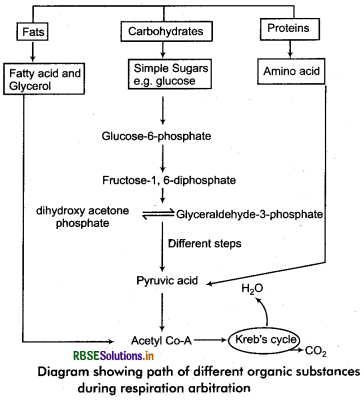
Question 7.
What do you understand by respiratory quotient (RQ)? Give RQ values for different food materials.
Answer:
In the process of respiration, the oxidation of various organic substances takes place in which usually oxygen is absorbed and carbon dioxide is evolved. The ratio between the volume of these two gases is known as respiratory quotient.
“The ratio of the volume of CO2 evolved to the volume of O2 absorbed in respiration at the given time, temperature and pressure, is called respiratory quotient
(RQ).
Respiratory Quotient (RQ) \(=\frac{\text { Volume of } \mathrm{CO}_{2} \text { evolved }}{\text { Volume of } \mathrm{O}_{2} \text { absorbed }}\)
The value of RQ depends upon the nature of respiratory substrate or the amount of O2 present in the respiratory substrate and its oxidation. The value of RQ varies with different food substances. The RQ of different substrates can be explained by the following examples:
1. Carbohydrates: The RQ of carbohydrates is one or unity because the volume of CO2 evolved during this process is equal to the volume of O2 absorbed. It is shown by the following way:
C6H12O6 + 6O2 → 6CO2 + 6H2O + energy
\(\mathrm{RQ}=\frac{\text { Volume of } \mathrm{CO}_{2} \text { evolved }}{\text { Volume of } \mathrm{O}_{2} \text { absorbed }}=\frac{6}{6}=1 \text { or unity }\)
2. Fats or Oils: When fats or oils are used as respiratory substrates. The value of RQ is always less than one because their molecules have less quantity of O2 in comparison to carbohydrates. Therefore, their oxidation requires more O2 and then CO2 liberation is less and RQ becomes less than unity.

\(\begin{gathered} \mathrm{RQ}=\frac{\text { Vol. of } \mathrm{CO}_{2} \text { evolved }}{\text { Vol. of } \mathrm{O}_{2} \text { absorbed }} \\ =\frac{102}{145}=0.7 \text { (less than unity) } \end{gathered}\)
3. Proteins: When proteins are used as respiratory substrates, the value of RQ is less than unity. Like fats, in proteins also the amount of O2 is less in comparison to carbon .i.e., they require more oxygen and evolve less carbon dioxide during their complete oxidation. The value of RQ of proteins usually lies between 0.4 - 0.9.
4. Organic Acids: For organic acids, the value of RQ is more than one. Organic acids have more O2 in comparis ion to carbon, i.e., less amount of O2 is required for the oxidation of organic acids and the quantity of evolved CO2 is more than the absorbed O2.

\( \begin{aligned} \mathrm{RQ} &=\frac{\text { Volume of } \mathrm{CO}_{2} \text { evolved }}{\text { Volume of } \mathrm{O}_{2} \text { absorbed }} \\ &=\frac{4}{3}=1.33 \text { (more than unity) } \end{aligned}\)
Similarly, the value of RQ of citric acid and oxalic acid is 1.33 and 4, respectively.
5. Incomplete Oxidation of Carbohydrates: In succulent plants, such as Euphorbia, Opuntia, several other cactus etc., and plants with red coloured leaves, the organic acids are formed by the incomplete oxidation of carbohydrates. In this process, CO2 is not evolved therefore, the RQ in such plants is zero.

\(\begin{aligned} \mathrm{RQ} &=\frac{\text { Volume of } \mathrm{CO}_{2} \text { evolved }}{\text { Volume of } \mathrm{O}_{2} \text { absorbed }} \\ &\left.=\frac{0}{3}=0 \text { (zero }\right) \end{aligned}\)
During days the complete oxidation of these acids takes place in these plants, due to which CO2 is evolved. Therefore, during day, the value of RQ is more than one because the RQ of organic acids is more than one.
C6H6O5 + 3O2 → 4CO2 + 3H2O (In day time)
\(\begin{aligned} \mathrm{RQ} &=\frac{\text { Volume of } \mathrm{CO}_{2} \text { evolved }}{\text { Volume of } \mathrm{O}_{2} \text { absorbed }} \\ &=\frac{4}{3}=133 \text { more than unity. } \end{aligned}\)
6. In anaerobic respiration, O2 is not used but CO2 is evolved. In this situation, the value of RQ is infinite (∝) as shown by the following equation.
C6H12O6 → 2C2H5OH + 2CO2
\(\begin{aligned} \mathrm{RQ} &=\frac{\text { Volume of } \mathrm{CO}_{2} \text { evolved }}{\text { Volume of } \mathrm{O}_{2} \text { absorbed }} \\ &=\frac{2}{0}=\infty \text { (Indefinite) } \end{aligned}\)
RQ is measured by respirometer (Ganong’s respirometer).
